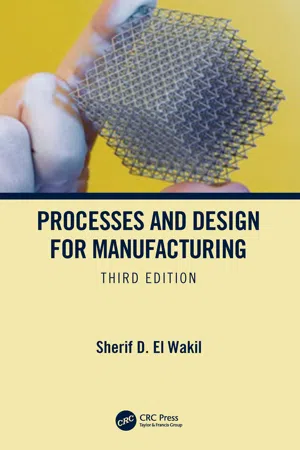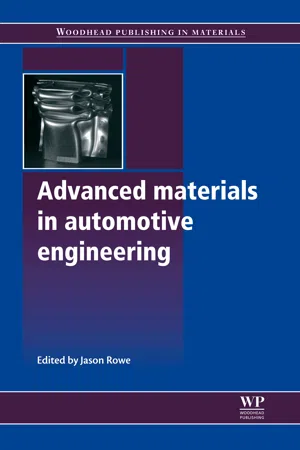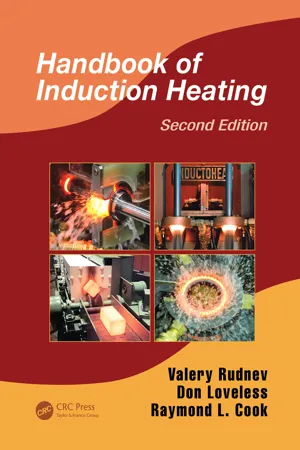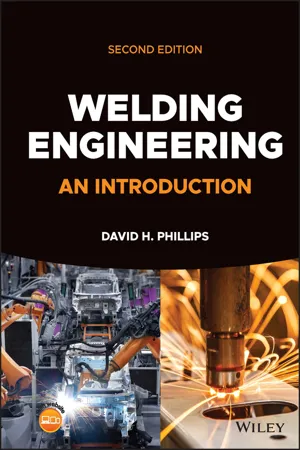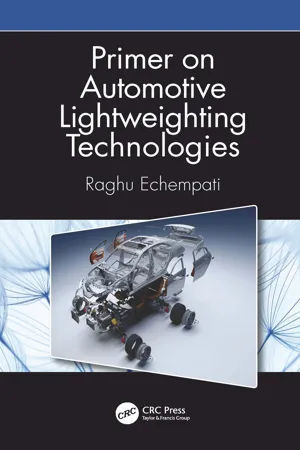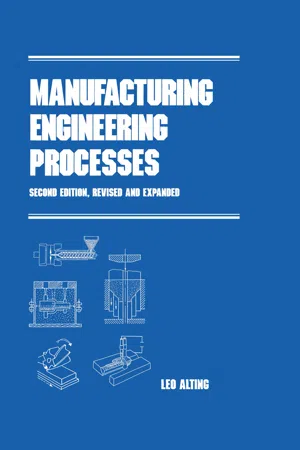Technology & Engineering
Metal Joining
Metal joining refers to the process of connecting metal parts to form a single, functional unit. This can be achieved through various methods such as welding, brazing, soldering, and mechanical fastening. The choice of joining method depends on factors like the type of metals being joined, the intended application, and the desired strength of the joint.
Written by Perlego with AI-assistance
Related key terms
Related key terms
1 of 4
Related key terms
1 of 3
9 Key excerpts on "Metal Joining"
- eBook - ePub
- Henry Tindell(Author)
- 2022(Publication Date)
- The Crowood Press(Publisher)
3 Metallurgical joiningThis is an extremely important sector of joining metals that is fundamentally different from mechanical joining, where the latter often requires only a minimal amount of tooling, such as hole drilling, clamping and bolt tightening. For metallurgical joining, it is necessary to heat the job, plus a host of other requirements such as joint shielding, ‘filler’ materials and ancillary equipment. In short, without sufficient process knowledge and equipment, it cannot be reliably undertaken.Despite this, for such a powerful and useful facility to be neglected is unthinkable, wherever there is the need for the joining of metals. As can be seen from the earlier piece on the history of metallurgical joining, it forms an extremely diverse range of processes – from those that are relatively simple and accessible in the home workshop, such as soldering and gas welding of mild steel, to the highly sophisticated industrial processes, such as the electron beam welding of titanium alloys for aerospace work.In order to make some sense of this diversity, and make useful choices, it is possible to categorize this into non-fusion and fusion joining. NON-FUSION PROCESSES This includes soldering, brazing, diffusion bonding, and similar. Non-Fusion joiningThis is an important aspect of joining, which is long-established and generally the most accessible of the metallurgical methods as it includes soldering. ‘Soft soldering’, with the relatively low temperatures of around 250–350°C, requires only a simple electrical soldering iron to melt the solder. The basic requirements are for a metallurgically clean joint, such as from surface abrasion by the normal workshop tools and abrasive materials, a chemical flux and the low-temperature solder. This copes well with steel and the copper-based alloys such as brass. It is commonly used for electrical wiring and lightweight components in circuitry, but it can also provide an extremely useful technique for light sheet metalwork. - eBook - ePub
- T F Waters(Author)
- 2017(Publication Date)
- CRC Press(Publisher)
Most products are made by assembling a number of component parts, and many of these constituent items need to be joined together either permanently or in such a way that they can be subsequent taken apart again for maintenance or repair purposes. It is therefore essential that today’s design engineers are aware of the extensive range of joining methods readily available to modern industry and understand the fundamental principles involved in each process. The principal advantages and limitations of each technology should also be appreciated and joints designed accordingly.Tradition dies hard, and it is often all too easy to follow the joining methods used successfully in the past without giving due consideration to the more modern, economically attractive, options now available.5.1 The principal joining processes
The main joining processes used in manufacturing are welding, brazing, soldering, adhesive bonding and mechanical fastenings.hr/>Exercise Before reading further, list as many different joint applications as you can think of (from mending a broken cup to welding together the hull of a ship), stating which joining process you think each employed. Carefully save your list until you have worked through this chapter, as Question 5.1 is based upon its use.5.2 Welding processes
When one wishes to join together two or more parts permanently with a joint having strength at least equal to that of the material(s) from which the constituent parts are made, some form of welding is normally required. While a large number of welding methods are available, the majority of applications are well catered for by a relatively small group of processes.There are many general textbooks available (Niebel 1989, DeGarmo 1989, Gourd 1986) that include descriptions of the more specialized welding techniques, but the processes listed in Table 5.1 - Sherif D. El Wakil(Author)
- 2019(Publication Date)
- CRC Press(Publisher)
4 Joining of Metals When two parts of metal are to be attached together, the resulting joint can be made dismountable (using screws and the like), or it can be made permanent by employing riveting, welding, or brazing processes. The design of dismountable joints falls beyond the scope of this text and is covered in machine design. It is, therefore, the aim of this chapter to discuss the design and production of permanent joints when various technologies and methods are applied. Because the same equipment used in welding is also sometimes employed in the cutting of plates, thermal cutting processes will also be discussed in this chapter. 4.1 Riveting The process of riveting involves inserting a ductile metal pin through holes in two or more sheet metals and then forming over (heading) the ends of the metal pin so as to secure the sheet metals firmly together. This process can be performed either cold or hot, and each rivet is usually provided with one preformed head. Figure 4.1 a,b indicates the sequence of operations in riveting, while Figure 4.2 illustrates different shapes of preformed rivet heads. FIGURE 4.1 The sequence of operations in riveting: (a) flat-head rivet and (b) regular rivet. FIGURE 4.2 Different shapes of preformed rivet heads. 4.2 Welding Welding is the joining of two or more pieces of metal by creating atom-to-atom bonds between the adjacent surfaces through the application of heat, pressure, or both. In order for a welding technique to be industrially applicable, it must be reasonable in cost, yield reproducible or consistent weld quality, and, more important, produce joints with properties comparable to those of the base material. Various welding techniques have been developed that are aimed at achieving these three goals. However, no matter what welding method is used, the interface between the original two parts must disappear if a strong joint is to be obtained- Yoseph Bar-Cohen(Author)
- 2018(Publication Date)
- CRC Press(Publisher)
12 Metal Joining Techniques Using BrazingYoseph Bar-Cohen , Dusan P. Sekulic , Rui Pan , Sudarsanam Suresh Babu , Anming Hu , Denzel Bridges , Xiaoqi Bao , Mircea Badescu , Hyeong Jae Lee , and Stewart Sherrit12.1 Introduction to Brazing12.1.1 Metal Joining Methods12.1.2 Process of Brazing12.1.3 General Applications of Brazing12.1.4 Design for Brazing12.2 Brazing: Science and Technology Issues12.2.1 System Definition and Phenomenology of the Brazing Process12.2.2 Process Conditions12.2.3 Joint Domain12.2.4 Wetting and Spreading of Molten Metal12.3 Modeling Brazing Materials for Properties and Performance12.3.1 Computational Models for Design for Braze Joint12.3.2 Computational Models for Braze Materials and Processes12.4 Typical heating methods12.4.1 Furnace Heating12.4.2 Induction Heating12.4.3 Resistive Heating12.4.4 Nanobrazing—Heating and Brazing at Lower Melting Temperature12.4.5 Laser Brazing12.5 Application of Brazing12.5.1 High-Temperature Alloys12.5.2 Planetary Application—Breaking the Chain of Contact to Mars and Other Planets12.5.2.1 Materials Properties12.5.2.2 Cylindrical Container Configuration Concept12.5.2.3 Spherical Container Configuration Concept12.5.2.4 Nanobrazing —Heating and Brazing at a Lower Melting Point12.6 Summary/ConclusionsAcknowledgments References12.1 Introduction to Brazing12.1.1 Metal Joining MethodsGenerally, there are three most dominant methods of materials (metal–metal, metal–nonmetal, or nonmetal–nonmetal) joining involving the use of melting as a form of integrating parts. These methods are soldering, brazing, and welding. The distinction among these methods is as follows and the focus of this chapter is on brazing, of either metals or nonmetals (e.g., ceramics). Joining methods that are based on adhesive bonding are described in Chapter 11 , while diffusion bonding is covered in Chapter 13- eBook - ePub
- Jason Rowe(Author)
- 2012(Publication Date)
- Woodhead Publishing(Publisher)
12Joining technologies for automotive components
F.M.De. Wit and J.A. Poulis, Technical University Delft, The NetherlandsAbstract:
This chapter reviews key joining methods for automotive materials. It first summarises the main classes of material used in automotive engineering. The chapter then goes on to discuss different joining technologies such as laser beam welding and brazing, adhesive bonding and mechanical fastening techniques such as folding and riveting. It also reviews hybrid joining systems.Key words automotive engineering laser beam welding brazing adhesive bonding mechanical fastening techniques folding riveting hybrid joining systems12.1 Introduction
A priority for automotive engineers is reducing the weight of a car since this is directly related to fuel economy. Developments like the design of the power source and train (e.g. smaller engines with similar to better performance than their larger predecessors) contribute to lowering overall weight. However, making structural parts lighter, while still meeting safety requirements, remains critical to decreasing weight. using stronger steels to create thinner panels has reduced weight significantly. Improvements in modelling have also made it easier to optimise component strength and stiffness whilst minimising weight. Another trend is to use lighter materials (e.g. composites) for components that are not critical to structural integrity. In recent years there has been a greater focus on recycling, which has placed greater emphasis on the most efficient use of materials as well as those materials that can most easily be recycled. The challenge of weight reduction is greater because, while structural parts have become lighter, the increased use of electronics, new power systems (e.g. batteries and engines in electric and hybrid vehicles) and comfort systems (e.g. air conditioning) have added significantly to car weight. - eBook - ePub
- Valery Rudnev, Don Loveless, Raymond L. Cook(Authors)
- 2017(Publication Date)
- CRC Press(Publisher)
5 Joining Applications There are a number of ways to join parts together. Some of the conventional methods include brazing, soldering, welding (TIG, spot, rolling resistance), gluing, screwing, bolting, riveting, and others. Screws, bolts, and threaded items provide a mechanical bond and are utilized when an assembly must be capable of being relatively easy to take apart. Components that do not require disassembly are welded, brazed, or soldered as these processes create permanent joints [ 360 ]. Induction heating is commonly used to join metal components. This chapter focuses on the following typical induction joining applications: brazing, soldering, bonding, and shrink fitting. The pieces being joined can be of the same material or distinctly different materials. In the cases of brazing and soldering, both joined components should be metallic and heated to approximately the same temperature (e.g., soldering of radiators, brazing of the hard insert into a drill tip, assembling superalloy turbine blades and nickel metering plates, brazing hydraulic fittings, orthodontic parts, tubular assemblies, plumbing fixtures, and the working tips of tool bits for the mining industry, to name a few). In contrast, when bonding and shrink fitting, only one metallic component might be heated. For example, metal threaded inserts that are heated by induction and then pressed into a thermal set plastic component. 5.1 Brazing and Soldering by Induction Brazing and soldering are two of the most popular induction joining applications [ 1, 7 – 10, 360 – 371 ], which are accomplished in a similar manner to other induction thermal processes such as hardening, except quenching usually does not apply and the required temperatures might be somewhat lower (particularly for soldering, though brazing temperatures may be quite close to hardening) - eBook - ePub
Welding Engineering
An Introduction
- David H. Phillips(Author)
- 2023(Publication Date)
- Wiley(Publisher)
6 Other Approaches to Welding and JoiningWhereas the previous chapters covered in some detail the conventional industrial metal welding process families of arc, resistance, solid-state, and HED welding, this chapter provides a brief overview of many other ways both metals and nonmetals are joined. The word “joining” is introduced here to include processes like brazing, soldering, and adhesive bonding, which are not true welding processes. New to this second edition is an introduction to additive manufacturing (AM) which is rapidly becoming an important topic in manufacturing that relies on several common welding processes. Methods for mechanical fastening are beyond the scope of this book, and therefore, are not covered.6.1 Brazing and Soldering
Brazing and Soldering are joining processes that rely on filler metals that melt at temperatures below the melting temperature of the base metal being joined. Because the processes do not depend on base metal melting, they are not considered welding processes. Per AWS, the process is considered Brazing when the filler metal melts above 450°C (842°F), and considered Soldering when the filler metal melting temperatures are below 450°C. Although these processes do not exceed the melting point of the base metals being joined, it is not unusual for Brazing to produce some localized base metal melting due to a chemical reaction with the braze alloy which lowers the melting point of the base metal. But excessive melting can sometimes create a problem known as base metal erosion.Brazing and Soldering both require that the molten filler metal wets and flows through the joint via capillary action. Capillary action relates to the force of attraction that can occur between a liquid and a solid. A classic approach to verifying capillary action is to dip a small diameter tube into a liquid and observe the extent to which the liquid rises up the tube (Figure 6.1 - eBook - ePub
- Raghu Echempati(Author)
- 2021(Publication Date)
- CRC Press(Publisher)
6.10 ). It is a process where two metals are stacked on top of each other followed by a layer of explosive powder being placed on top of the plates. Upon detonating the explosives, a huge amount of downward force is applied to the materials, thus welding them together. The process creates a wavy interface between the metals, increasing the shear strength of the bond. The process is typically used to weld together traditionally incompatible materials. The shock waves can produce pressures of up to 60 GPa.6.6.2.5 Mechanical Joining ProcessesThis topic has also been discussed before from a different perspective. Until recently, mechanical joining was the main technology used to join aluminum and steel components. In general, all the different mechanical joining methods used within the automotive industry are also suitable to join dissimilar metals [54 ]. However, depending on the material combination (strength and ductility of both partners), some limitations may exist in particular for mechanical joining techniques which are based on forming and cutting processes (i.e., clinching, self-piercing riveting, flow-drilling screws, etc.). In most cases, mechanical joining techniques are combined with adhesive bonding to increase the static and fatigue strength of joints and prevent deterioration of corrosion resistance of joints caused by contact between dissimilar metals.Hem flange bonding is the standard solution when aluminum and steel closure panels are joined. In order to prevent from problems related to galvanic corrosion and thermal deformation between an aluminum outer panel and a steel inner panel, an adhesive is used. Figure 6.53 shows the principle of this process.FIGURE 6.53Mechanism of laser-assisted metal and plastic joining [55 ].6.6.3 Joining Aluminum to PlasticsJoining aluminum to plastics is a challenging area. Adhesive bonding is the least expensive joining method for joining aluminum to plastics permanently but is not necessarily the best solution. For assemblies that must be taken apart a limited number of times, mechanical fasteners are the least expensive. However, if an assembly is intended to be taken apart regularly, metal inserts in the plastics are considered. Rivets also offer a simple, easily automated installation process that can be used in particular for plastic to sheet metal joints. - Alting(Author)
- 2020(Publication Date)
- CRC Press(Publisher)
8Solid Materials: Joining Processes8.1 INTRODUCTION
In previous sections the production of components in one solid piece has been discussed. Often, it is more economical, or in some cases the only practical possibility because of size or geometry, to build up the desired component by joining two or more elements produced by the methods formerly discussed. In this section the fundamental processes that can be used to join elements or components are described.If the elements (components) A and Bin Fig. 8.1 are to be joined, this can be done in three principal ways:- The elements can be joined permanently through localized coalescence based on cohesion and/or adhesion between the elements.
- The elements can be joined through a geometrical locking of the elements based on elastic or plastic deformation.
- The elements can be joined through the use of special joining elements or fasteners (rivets, bolts, etc.).
Cohesion , which means that the elements form common metallic crystals, is established through a suitable combination of temperature and pressure to create sufficient proximity and activity (i.e., the coalescence is based on atomic bonding forces)FIGURE 8.1 Joining of two elements A and B: (a) illustration of the problem; (b), (c) examples of joints based on the three fundamental principles (cohesion/adhesion, geometrical locking, joining elements).Adhesion means that the elements are bonded together through surface forces of physical, electrical, or chemical nature (i.e., the elements do not form common structures)Coalescence based on cohesion requires that the two elements have the same basic structure. This is not a requirement for adhesion; that is, different types of materials can be joined.
Index pages curate the most relevant extracts from our library of academic textbooks. They’ve been created using an in-house natural language model (NLM), each adding context and meaning to key research topics.
Explore more topic indexes
Explore more topic indexes
1 of 6
Explore more topic indexes
1 of 4


